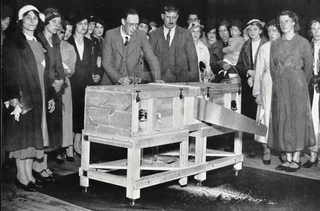
David Blaine is an American illusionist, endurance artist, and extreme performer. He is best known for his high-profile feats of endurance and has set and broken several world records.

The cups and balls is a performance of magic with innumerable adaptations. Street gambling variations performed by conmen were known as Bunco Booths. A typical cups and balls routine includes many of the most fundamental effects of magic: the balls can vanish, appear, transpose, reappear and transform. Basic skills, such as misdirection, manual dexterity, sleight of hand, and audience management are also essential to most cups and balls routines. As a result, mastery of the cups and balls is considered by many as the litmus test of a magician's skill with gimmick style tricks. Magician John Mulholland wrote that Harry Houdini had expressed the opinion that no one could be considered an accomplished magician until he had mastered the cups and balls. Professor Hoffman called the cups and balls "the groundwork of all legerdemain".

Levitation or transvection, in the paranormal or religious context, is the claimed ability to raise a human body or other object into the air by mystical means.

Card manipulation is the branch of magic that deals with creating effects using sleight of hand techniques involving playing cards. Card manipulation is often used in magical performances, especially in close-up, parlor, and street magic. Some of the most recognized names in this field include Dai Vernon, Tony Slydini, Ed Marlo, S.W. Erdnase, Richard Turner, John Scarne, Ricky Jay and René Lavand. Before becoming world-famous for his escapes, Houdini billed himself as "The King of Cards". Among the more well-known card tricks relying on card manipulation are Ambitious Card, and Three-card Monte, a common street hustle also known as Find the Lady.

Coin magic is the manipulating of coins to entertain audiences. Because coins are small, most coin tricks are considered close-up magic or table magic, as the audience must be close to the performer to see the effects. Though stage conjurers generally do not use coin effects, coin magic is sometimes performed onstage using large coins. In a different type of performance setting, a close-up coin magician will use a large video projector so the audience can see the magic on a big screen. Coin magic is generally considered harder to master than other close-up techniques such as card magic, as it requires great skill and grace to perform convincingly, and this requires much practice to acquire.
The King Rising levitation is a levitation illusion developed by and named after Corey King sold exclusively through Ellusionist. The King Rising was the first original magic effect to be released by the company, paving the way for many inventors to come. Some consider it to be a variation of the Balducci levitation.

Sawing a woman in half is a generic name for a number of stage magic tricks in which a person is apparently cut or divided into two or more pieces.
The Asrah levitation, sometimes called Lighter than Air, is a classic levitation illusion.
The bullet catch is a stage magic illusion in which a magician appears to catch a bullet fired directly at them — often in the mouth, sometimes in the hand or sometimes caught with other items such as a dinner plate. The bullet catch may also be referred to as the bullet trick, defying the bullets or occasionally the gun trick.

Street magic falls into two genres; traditional street performance and guerrilla magic.
The Indian rope trick is a magic trick said to have been performed in and around India during the 19th century. Sometimes described as "the world’s greatest illusion", it reputedly involved a magician, a length of rope, and one or more boy assistants.
This is a glossary of conjuring terms used by magicians.
Needle-through-arm is a magic illusion that was created by Bruce Spangler and later popularized by comedy actor/magician Harry Anderson. The trick can be performed as part of either a stage magic or a parlor magic routine. As the name would suggest, needle-through-arm relies on shock value to have a comedic effect.
David Copperfield has performed a levitation illusion in several magic shows since 1992 in which he appears to fly on stage for several minutes, while surrounded by audience members. The flight is notable for its graceful motion and unencumbered appearance. The illusion was included in Copperfield's CBS TV special The Magic of David Copperfield XIV: Flying—Live The Dream (1992), and has been repeated several times during Copperfield's live tours around the world. The method was created by John Gaughan. An essential contribution to make fluid movements was given by his assistant, dancer and choreographer Joanie Spina.

Peter Marvey is a magician and illusionist best known for his combination of sleight of hand and large-scale stage illusions.

Magic, which encompasses the subgenres of illusion, stage magic, and close-up magic, among others, is a performing art in which audiences are entertained by tricks, effects, or illusions of seemingly impossible feats, using natural means. It is to be distinguished from paranormal magic which are effects claimed to be created through supernatural means. It is one of the oldest performing arts in the world.

Jason Latimer, known by the stage name LATIMER, is an American illusionist. In 2003, he became one of four Americans ever to win the title Grand Prix "Best Overall" at the World Championships of Magic. In 2012, Latimer starred in the six live British television specials on the BBC One's "The Magicians," and won UK competition overall. In 2014, Latimer joined Penn & Teller and Christen Gerhart as a judge on the American magic competition television series Wizard Wars on the Syfy channel. In 2015, Latimer launched the Impossible Science program in San Diego, CA. Currently, Latimer is the curator of Impossible Science for the Fleet Science Center and oversees the Impossible Science Initiative in science centers throughout Southern California. Jason co-hosts Science Channel's series SciJinks with The Big Bang Theory's Johnny Galecki and Mythbusters: The Search's Tamara Robertson. In 2018, Jason joined the likes David Copperfield and David Blaine as one of the few recipients of the prestigious Golden Grolla Award from the Masters of Magic in Saint-Vincent, Italy. In 2018, Jason was the closing speaker of the USA Science and Engineering Festival in Washington, D.C., for recognition of Impossible Science and changing education with wonder.

A levitation illusion is one in which a magician appears to defy gravity by making an object or person float in the air. The subject may appear to levitate unassisted, or it may be performed with the aid of another object in which case it is termed a "suspension".










